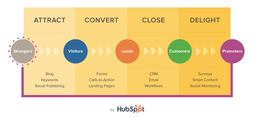|
Marketers increasingly recognize the importance of localizing websites, but many only translate their product and service pages and often into only one or two languages. While we all know that the customer experience is king and that inbound marketing (thanks Hubspot) will radically improve our sales, we continue to neglect to localize for customer experience, and we overlook localizing inbound funnel content.  Take, for example, Hubspot’s classic inbound marketing funnel. You can find this on their website. Hubspot defines 4 steps in the inbound marketing process: Attract, Convert, Close, and Delight. To reach all of your potential customers, you need to localize your content for each step. 1. Attract Notice that product and service pages do not even appear on the chart. The sales process begins with blogs, keywords, promotional videos, and social media, for which you need to create content that piques interest and draws visitors in. This means that if you want to attract customers to your website to see your localized product and service pages, you need to make sure you’re also localizing your social media, that you’ve optimized your SEO for the local market, and that you’re blogging in local languages. Localizing the attraction portion of your funnel requires more than just translating what you’ve written in English. You need to truly understand your customer and then tailor your messaging for that market and to the local language. Start by drawing up a list of customer attributes and then find all the information you can to see how those attributes differ across country borders and how you need to modify and talk about your offerings. Keep in mind that you may even need to tailor your marketing within a country. Think about regional, cultural, and linguistic differences within the U.S. Are you customizing your social media marketing to take advantage of the different niches? Buying habits vary greatly across cultures. For instance, only 20% of German customers use credit cards and many Japanese consumers pick up their packages at local convenience stores and pay COD.(+) Find out how buyers differ across your market and optimize your SEO ads and blog content for those differences. Finally, research how your customers access your website. Do they prefer a desktop, a tablet, or a mobile phone? During they access your site during business hours, leisure time, or on their commute? Recognizing the differences between your international consumers will help you better target your keyword ads, time your email campaigns, and blog about what resonates for them. 2. Convert By this point you’ve gotten the word out, and people are showing up on your site. You have a local team tweeting about your brand and your blogs are relevant. No longer is your Brazilian market hearing about how great it is that summer has arrived when they’re watching the leaves fall. The next step is converting those visitors. When a customer in Spain reacts to an ad, does he arrive on a localized landing page? Is the CTA relevant for his purchasing potential? Again think about how your South American visitors might be more interested in purchasing a sweater in July than a bathing suit. What about your forms? If you want Susi Q to sign up for email offers or company news, you need to translate your forms and adjust them for the local market. The last thing you want is to get someone to visit your website only to discover that the pages you so painstakingly created to explain your brand are only in English. Remember, you’ve done your homework and created tons of rich content, designed to educate and entice. Now follow through by translating them and adjusting them to attract your local customers. Dramatically increase your conversion rates by putting a process in place whereby all your content gets localized. 3. Close You’ve almost made the sale. Here’s where it helps to know payment and shipping preferences. Can you deal with the COD customer? Have you included all the duties and taxes in the price of your product or do they get tacked on at the end as an unfortunate surprise? How long will it take you to ship the product? Do you have local distribution centers or are you shipping on a slow boat from the U.S? If you’ve captured information about the customer in a form, do you have localized content that you can send that will tip him into purchasing? Think through the end of the sale. This is where you work not only to close the sale but also to get repeat business. Your follow up emails should be localized. Find out what level of post-purchase service competitors in the local market provide and go above and beyond to ensure your customers are delighted. Which brings us to: 4. Delight Hubspot lists surveys, smart content, and social marketing as three areas you should be using to delight your customer. Again, they should be tailored for the local market. This doesn’t just mean translated, but also adjusted to gather and provide information on what is important to your customer. Telefonica, a Spanish telephone company, realized that it needed to improve its customer experience, so it opened regional call centers both within Spain and in overseas locations. It wanted its Spanish customers to be able to talk to people who spoke the same dialect, walked the same streets, and could form connections with them. Telefonica also realized that it had different competitors in different regions, and by opening local call centers, they could respond to customer needs more rapidly, more effectively, and more competitively because their reps would know the local market better. Now Telephonica is working to make a seamless user experience for customers that walk into a shop and then contact the company through the website or by phone. Telefonica wants to make sure that customers get consistent information that is relevant to their market and their needs. This goes far beyond translation, to a strategic localization effort that works to consistently delight the customer. (++) From your earliest outreach to post-sale engagement, you need to think about what your local customer needs and responds to and make sure that your marketing content reflects that. This doesn’t mean that you need to create new content for every market, rather, create stellar content and then adjust it and localize it for each market. Your increased sales will justify the time and effort you put in. +(MultiChannelMerchant article Global Ecommerce on the Rise as Options for Addressing Barriers Increase, June 2015) ++ (http://www.customerexperiencereport.com/strategy-and-trends/telefonica-localized-customer-experience/)
4 Comments
This is great! Using a strategic localization makes your sales grow. Adding to that, in this amends of pandemic socialization is very important. To avoid getting the virus, when you are sharing your information you can use an upgraded business card using the phone. Easy to use and friendly use.
Reply
Leave a Reply. |
Author
Archives
March 2024
Categories
All
|
Photos from : : Ys [waiz] : :, bjahind, fabola, MattysFlicks, @sage_solar, LoS, Traducción e Interpretación, Kyle Taylor, Dream It. Do It., _gee_, keepitsurreal, One Way Stock, Airviewsphotos, GotCredit, efile989, Benoit cars, ** RCB **, stephiesal853, Francisco Anzola, Highways England, ITU Pictures, VIPevent, leoplus, Karsten Bitter, Jolante, jobstop11, Nguyen Vu Hung (vuhung), jurvetson, mikefats, YooSan, sandrafdzh, roland, mikecogh, y entonces, Donald Lee Pardue, Gatorgoon, daniel0685, BÜNDNIS 90/DIE GRÜNEN, rick, {Guerrilla Futures | Jason Tester}, mikecogh, markyharky, amslerPIX, jo.sau, IAEA Imagebank, lisa-skorpion, Toronto Public Library Special Collections, Wootang01


 RSS Feed
RSS Feed
